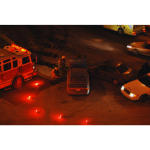Individuals injured in Florida car accidents have the legal right to seek compensation for their damages. This compensation extends beyond just covering present and future medical expenses and costs to replace or repair property damage. Victims also have the right to pursue compensation for the pain and suffering they experience due to injuries or having to endure the dramatic event. This includes both present pain and suffering as well as any continuing pain and suffering. This means that beyond addressing immediate medical needs, individuals can seek financial restitution for the emotional distress, physical discomfort, and diminished quality of life they experience from the aftermath of a Florida car accident. Such compensation acknowledges and aims to provide support and justice for the profound impact that car accidents can have on victims.
One common reason for seeking pain and suffering compensation for car accident victims is herniated discs. These injuries can result in significant discomfort and both physical and mental impairment, impacting the victim’s ability to carry out daily activities and may diminish their quality of life. In a herniated disc settlement without surgery, this compensation can provide financial relief to cover medical expenses and address the ongoing pain and suffering experienced by the individual. This type of settlement acknowledges the long-term consequences of the injury, aiming to alleviate both the physical and emotional, their ongoing pain takes on the victim.
What Is A Herniated Disc?
A herniated disc injury caused by a Florida car accident involves damage to one of the rubbery cushions, or discs, located between the vertebrae of the spine. These discs are the bodies natural shock absorbers and allow for flexibility in the spine. Each disc in the spine consists of a soft, jelly-like center called the nucleus, surrounded by a tougher, rubbery covering known as the annulus.
When a herniated disc occurs, part of the nucleus sticks through a tear in the annulus. This condition is also referred to as a slipped or ruptured disc. While herniated discs can happen anywhere along the spine, they most commonly present themselves in the lower back. Depending on the location of the herniated disc, individuals may experience no symptoms or painful symptoms. In severe herniated disc cases, surgical intervention, such as a discectomy, may be necessary to alleviate symptoms and restore function.
Common Symptoms Of A Herniated Disc
After a car accident in Florida, it’s important to understand that the symptoms of a herniated disc may not present themselves immediately due to the adrenaline and shock experienced during the crash. Therefore, it’s important for individuals involved in Florida car accidents to familiarize themselves with the symptoms associated with a herniated disc so that they can receive timely and appropriate medical attention if needed.
- Arm or Leg Pain – Depending on the location of the herniated disc, victims with a herniated disc may experience pain in the:
- Lower back
- Buttocks
- Thigh
- Calf
- Foot
In cases of a herniated disc in the neck, pain is typically experienced in the shoulder and arm, sometimes with it radiating into the arm or leg during certain movements.
- Sharp or Burning Pain – The pain associated with a herniated disc is often described as sharp or burning. Pain typically presents itself when coughing, sneezing, or assuming certain positions such as bending over.
- Numbness or Tingling – Radiating numbness or tingling sensations in the body may occur in the body part that the affected nerves serve. This numbing or tingly sensation is commonly experienced in the arms or legs.
- Weakness – Muscles attached to the affected nerves may weaken, potentially leading to stumbling or affecting the ability to lift or hold items.
- Asymptomatic Herniated Discs – It is possible to have a herniated disc without experiencing any symptoms. However, the condition can become apparent through spinal imaging.
It’s important to seek medical attention if neck or back pain extends down the arm or leg, or if there are accompanying symptoms such as numbness, tingling, or weakness. Not treating a herniated disc could not only result in worsening conditions, but could also affect a herniated disc pain and suffering settlement.
How Is The Average Settlement For Discectomy Determined?
When determining the average settlement for discectomy or herniated disc pain and suffering settlement, various factors are taken into consideration by the court or jury. These factors include:
- Extent and Duration of Personal Injuries – The severity and length of time the individual has been affected by the herniated disc injury. A pain and suffering settlement for herniated disc will increase if the injury is determined to be severe, or requires surgical intervention through a discectomy.
- Type of Medical Treatment – The nature and extent of medical care received by the victim to address their injuries is considered, including any future medical treatment they may need like additional surgeries or physical therapy.
- Overall Impact on Well-being – How the injuries have affected the plaintiff’s overall physical health and emotional well-being. Settlements typically increase in value if PTSD, depression, or suicidal ideation are experienced by the car accident victim.
- Limitations on Activities – Assessing how the injury has restricted the individual’s ability to engage in daily activities, such as going to work, performing household chores, etc., is part of determining a settlement amount for herniated discs.
- Impact on Interactions – Understanding how the injury has affected the victim’s ability to interact with family and friends is crucial in determining pain and suffering settlements after a herniated disc injury.
- Ability to Enjoy Life – Considering the degree to which the injury has diminished the individual’s enjoyment of life is a big factor in determining settlement values.
- Mental and Physical Pain – Evaluating both past suffering and anticipated future pain resulting from the injury is important. If a victim is expected to experience pain and suffering for a long period of time, their settlement will typically increase.
- Recovery Length and Prognosis – The expected duration of recovery and the long-term outlook for the individual’s health are factored in. If they are unable to make a full recovery from their herniated disc, then they may be entitled to more compensation for pain and suffering.
- Disfigurement and Embarrassment – Assessing any physical changes resulting from the injury and the associated emotional impact are an important factor to determining the value of pain and suffering settlements for herniated discs. If a person is unable to stand properly due to a herniated disc, then they may be entitled to more compensation.
- Age of the Victim – Recognizing the impact of a herniated disc and the individual’s age are important in determining their ability to recover from and cope with the injury.
While these factors guide the assessment of compensation, the ultimate decision rests with the jury or judge presiding over the case. They will weigh all the evidence presented in the case to determine a fair and reasonable herniated disc pain and suffering settlement.
How To Prove Pain And Suffering
When proving pain and suffering for herniated disc settlements, an essential aspect is to present specific evidence that substantiates the extent of the individual’s non-economic losses. These factors play a critical role in establishing the impact of the injury on the victim’s overall well-being, mental health, and quality of life.
- Medical Bills – Documentation of medical expenses related to the treatment of herniated discs are vital sources of evidence when proving that pain and suffering was endured by the individual.
- Medical Records – Detailed medical records are an important aspect of proving pain and suffering for herniated discs, including treatment plans and progress notes. They provide insight into the extent of the injuries and the associated pain and suffering they cause.
- Pictures of Injuries – Visual evidence, such as photographs, X-rays, or medical imaging of the injuries sustained is also important. These can be used to help illustrate the physical toll of the herniated discs and the resulting pain and suffering.
- Psychiatric Records – In cases where psychological distress accompanies physical pain, psychiatric records, or statements from therapists can demonstrate the emotional impact and further support the claim for pain and suffering.
- Missed Work Time – Documentation of the time missed from work, along with the wages the victim missed out on due to the herniated discs and associated symptoms, is a vital piece of evidence. These can highlight the impact on the individual’s daily life and functioning.
- Mental State – Evaluation of the individual’s mental state, including any psychological effects stemming from the pain and suffering, can be helpful when establishing the extent of non-economic losses in the claim.
Proving pain and suffering for herniated discs after a car accident often requires your Florida car accident lawyer collaborating with medical experts to provide further proof of the victim’s experience and determine the appropriate compensation amount they deserve for their non-economic losses.




